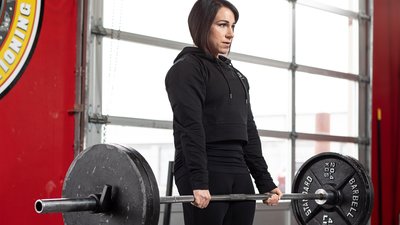The image that the words "powerlifting meet" bring to mind in most people is intense, to say the least. You might imagine gargantuan men and hella-strong women roaring while they move massive, rattling bars. Heavy-metal music blasts in the background, chalk and ammonia capsules litter the ground, and blood is in the air.
This is a shame, because I can assure you this isn't the scene at most powerlifting meets today—in fact, the scene is quite the opposite. You'll find men and women of many ages and strength levels competing. The atmosphere is relaxed, and the people are best described as down to earth.
Powerlifting is one of those rare sports where your competitors are likely to cheer you on—even if they're complete strangers. Rather than rooting against you, powerlifters realize that deep down, everyone is trying to be the best version of themselves. They also understand the arduous grind necessary to set new PRs, which is why they're quick to show love and support to anyone attempting a new best.
Sound like a great experience? It is. So what are you waiting for? Here are six steps to succeed at your first meet!
1. Actually Sign Up For A Meet
There's never going to be a perfect time to compete, so don't spend your life waiting for one. Just commit to a date, pay the registration fee, and get the ball rolling. Trust me, I know the feeling of constantly spinning your wheels and telling people you're going to do one. That was me. Three years later, I finally did one.
Similar to planning a wedding or a vacation, you can't truly begin to prepare until you know when exactly it will take place. And have no doubt: Preparing for a powerlifting meet takes extensive mental and physical preparation. Do yourself a favor and set aside plenty of time to prepare. I recommend signing up for a meet at least 3-5 months beforehand. But most importantly, get it on the calendar! Then you can work on your programming.
To seek out a local meet, I suggest visiting Powerlifting Watch, which has the most up-to-date information about meet dates and locations for numerous organizations.
Be aware that each organization has its own equipment, depth, and competition policies. When possible, sign up for a meet that aligns with how you train: raw (lifting belt and knee sleeves) versus geared (knee wraps, bench shirts, etc.). If travel is an issue, simply competing in a local meet is a great option to start, too.
2. Get Your Accessories Listed And Ready
We've all experienced the first-date butterflies that result in a stumbling of words and frequent awkward pauses. Believe it or not, your nerves will be 10 times worse before stepping under the bar for your first squat attempt. This will inevitably lead to questionable packing.

I recommend signing up for a meet at least 3-5 months beforehand. But most importantly, get it on the calendar! Then you can work on your programming.
I can't tell you how many times I've seen lifters squatting in tennis shoes or beltless—and it wasn't on purpose. Despite completing thousands of reps with the same shoes and the same belt, they forget to pack them when competition day arrives. Their nerves got the best of them.
To help ensure you're set up for success, prepare a checklist ahead of time, when anxiety is at its lowest, so that you have everything you need to be successful. Then, do yourself a favor and pack ahead of time—at least 24 hours in advance. This gives you plenty of time to triple check.
In most cases, you'll probably leave Friday night (if you're traveling) and compete Saturday, so you should be fully packed by Thursday evening.
Here's what I recommend as a starting point for your checklist:
- Shoes, 2-3 pairs (squat shoes, deadlift shoes, casual/lounge shoes)
- Socks, 2-3 pairs (competition socks, deadlift socks, socks for after the meet)
- Knee sleeves
- Lifting belt: Make sure yours meets width requirements.
- Wrist wraps: Again, make sure yours meet width requirements and you know how to apply them legally.
- Powerlifting singlet: This is required in all meets.
- Other gear, such as knee wraps or a bench shirt, as your meet's rules allow
- Appropriate undergarments for competition (bras, boxers, undershirts). Believe it or not, there are rules about this, so know them!
- Change of clothes for after (shirt, pants, shorts, jacket)
- Multiple snacks/meals (protein powder/bars, oats, granola bars, fruit, sandwich materials)
- Adequate drinks, plus an extra water bottle
- Pre-workout supplement if necessary
- Athletic tape
- Lifting chalk
- Baby powder
- Music-playing device and headphones
- Cash
- A training buddy
- A great attitude and a smile
3. Have A Competition Meal Schedule Ready
Competition nutrition can be extremely tricky. Think about it: Over the span of a few hours, you will maximally exert yourself nine times, clenching every muscle in your body while simultaneously bracing through your abdomen. How do you fuel for that? The slightest bit of discomfort is going to take away from your performance, but a lack of energy will have the same result. That's why having a plan is crucial to your success.
I've seen it all when it comes to competition-day choices, including guys scarfing down spaghetti and meatballs 30 minutes before their opening squat attempt (carb loading, duh) and gals scarfing down bags of gummy bears. I've even seen a guy inhaling spoonfuls of straight glutamine powder.
You need to have a firm idea as to when and what you'll eat, but at the same time, recognize that this may change based on competition flow and your nerves, both of which may inhibit your appetite.
First, make sure you have ample food on hand. You're better off with too much than too little. Whey protein, fruit, oats, protein bars, jerky, and sandwiches usually work well for most. Second, jot down at least a tentative plan of when you'd like to eat.
Here's what works best for me:
Medium Breakfast
I aim for a low-fat, moderate-protein breakfast with some complex carbohydrates. My go-to is a spinach-and-pepper omelet, fruit, and some oatmeal.

Small Snack 1-2 Hours Before Squats
At this time, I'm looking for something that will provide sustained energy but is light enough that it doesn't upset my stomach. I find a protein shake with an apple works well and doesn't bother me during warm-ups or my actual squat attempts.
Bigger Meal Before Squats
Three max-squat attempts leave me pretty hungry. Since the next exercise, the bench press, is a lot less demanding, I can afford to have a bigger meal without fear of an upset stomach during the lift. I usually have a sandwich at this time.
Small Meal After Bench Press
The deadlift may be the most taxing lift of all, so it's crucial to have adequate fuel for the lift. At the same time, the day has been fatiguing, so I'm usually tempted to eat more than I need. I like to start light here, usually with a shake and a piece of fruit, but I'll add oats if I feel I need more.
Finally, avoid "newtrition" on competition day. I don't care if the area you're competing in is famous for local cuisine; save it for after the meet. There's no one-size-fits-all approach to competition-day nutrition, but be sure you stick with familiar foods, and have plenty enough on hand in case the meet runs long (which most do).
It goes without saying that it's important to stay adequately hydrated during the day, too. Have plenty of water and electrolyte-containing fluids on hand to keep your mind and muscles strong. They may not be at the top of the checklist, but they can make a huge difference.
4. Go 9-For-9 In Your First Meet
Set the bar low at your first meet—and I don't mean the rack height for your squat. Chances are that you're not going to break any records at your first meet—that's OK! The first meet is all about experience. Focus on getting exposure to competition and building confidence under the bar when dozens or even hundreds of people are watching.
It's common to want to make a big showing or try to one-up your training max. In a word: don't. You'll be surprised how much a new atmosphere and the stress of competition will affect your mental and physical performance—and not always for the better.

Chances are that you're not going to break any records at your first meet—that's ok! The first meet is all about experience.
Be conservative. Each attempt should build confidence for the next. To start, set your opener at a weight you have done at least three times in training. Remember, once you tell the head judge your weight selection, you can't change it. When in doubt, drop a few kilos to make sure you successfully complete the repetition.
Lastly, take the time beforehand to plan out tentative attempts so you're mentally ready. A successful strategy I've used in the past is deciding on my first and second attempts ahead of time, and then choosing between three different options during the meet for my final attempt. This allows to me to have a plan for my final attempt that reflects my performance on the first two attempts as well as how I'm feeling mentally and physically.
5. Don't Cut Weight
You're toward the bottom of your weight class standards. Should you cut a few extra pounds to get into a lower weight class? No, you shouldn't. Sure, you may bump your Wilks score up a few ticks, but unless you're aiming to set some type of record, there's absolutely no need to cut weight. Save it for a future meet, not your first one.
Trust me, your first powerlifting meet will provide enough stress. Cutting weight will add further stress—both mentally and physically—that will almost always ultimately hinder your performance.
Enjoy your first meet and the entire process of getting there. Stressing out about not being able to eat or drink, or having to sit in a sauna to drop a few pounds, shouldn't be a part of the experience.
Save your mind and body for the weights. You'll thank me later.
6. Have A Training Partner With You
Having an experienced competitor backstage with you is invaluable. Unless you've hung around backstage at a lot of powerlifting meets, you won't know how they flow over the course of the day. And let's be honest, how many of these things start on time and run smoothly? Not many—and each one is different.

Having a friend backstage with you is invaluable. He or she will be able to help you manage warm-ups and apply chalk, while also providing the support and encouragement you need!
A seasoned competitor, or even someone with at least one competition under their belt, will help immensely in keeping you prepared throughout the day. They'll be able to manage the clock to get you warming up on time, help you work in on a warm-up rack, and also be there to set your weights, chalk your back, and provide you with the encouragement and support you need.
If you don't know an experienced competitor, don't stress. Powerlifters are very friendly and are usually willing to help. Just ask one, or ask to borrow the person who is helping them. But if possible, I recommend at least bringing your training buddy along for assistance. Heck, it may even convince him or her to compete in the future!
After the meet is over and you have a great time, let me know how it goes on social media or in the comments!

